LINCOLN NAUTILUS 2021 Owners Manual
Manufacturer: LINCOLN, Model Year: 2021, Model line: NAUTILUS, Model: LINCOLN NAUTILUS 2021Pages: 579, PDF Size: 6.9 MB
Page 271 of 579
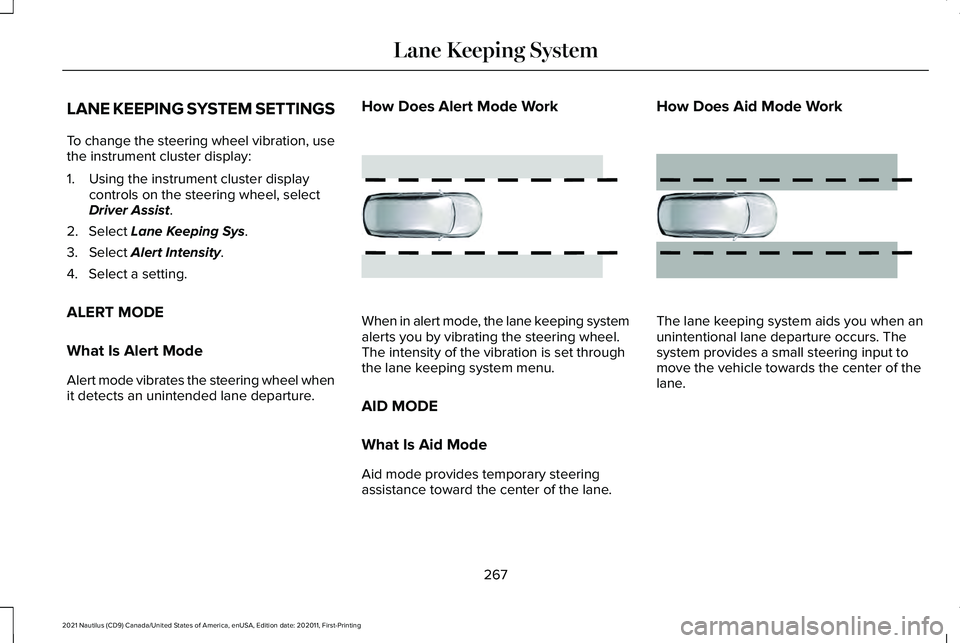
LANE KEEPING SYSTEM SETTINGS
To change the steering wheel vibration, use
the instrument cluster display:
1. Using the instrument cluster display
controls on the steering wheel, select
Driver Assist.
2. Select
Lane Keeping Sys.
3. Select
Alert Intensity.
4. Select a setting.
ALERT MODE
What Is Alert Mode
Alert mode vibrates the steering wheel when
it detects an unintended lane departure. How Does Alert Mode Work
When in alert mode, the lane keeping system
alerts you by vibrating the steering wheel.
The intensity of the vibration is set through
the lane keeping system menu.
AID MODE
What Is Aid Mode
Aid mode provides temporary steering
assistance toward the center of the lane.How Does Aid Mode Work
The lane keeping system aids you when an
unintentional lane departure occurs. The
system provides a small steering input to
move the vehicle towards the center of the
lane.
267
2021 Nautilus (CD9) Canada/United States of America, enUSA, Edition date: 202011, First-Printing Lane Keeping SystemE165515 E165516
Page 272 of 579
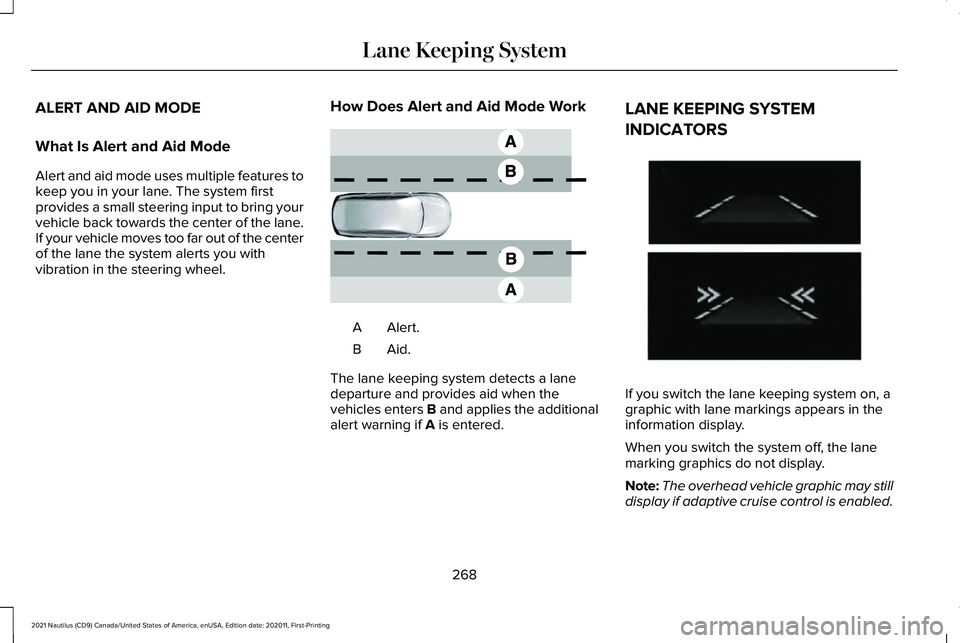
ALERT AND AID MODE
What Is Alert and Aid Mode
Alert and aid mode uses multiple features to
keep you in your lane. The system first
provides a small steering input to bring your
vehicle back towards the center of the lane.
If your vehicle moves too far out of the center
of the lane the system alerts you with
vibration in the steering wheel.
How Does Alert and Aid Mode Work Alert.A
Aid.B
The lane keeping system detects a lane
departure and provides aid when the
vehicles enters B and applies the additional
alert warning if A is entered. LANE KEEPING SYSTEM
INDICATORS
If you switch the lane keeping system on, a
graphic with lane markings appears in the
information display.
When you switch the system off, the lane
marking graphics do not display.
Note:
The overhead vehicle graphic may still
display if adaptive cruise control is enabled.
268
2021 Nautilus (CD9) Canada/United States of America, enUSA, Edition date: 202011, First-Printing Lane Keeping SystemE165517 E274073
Page 273 of 579
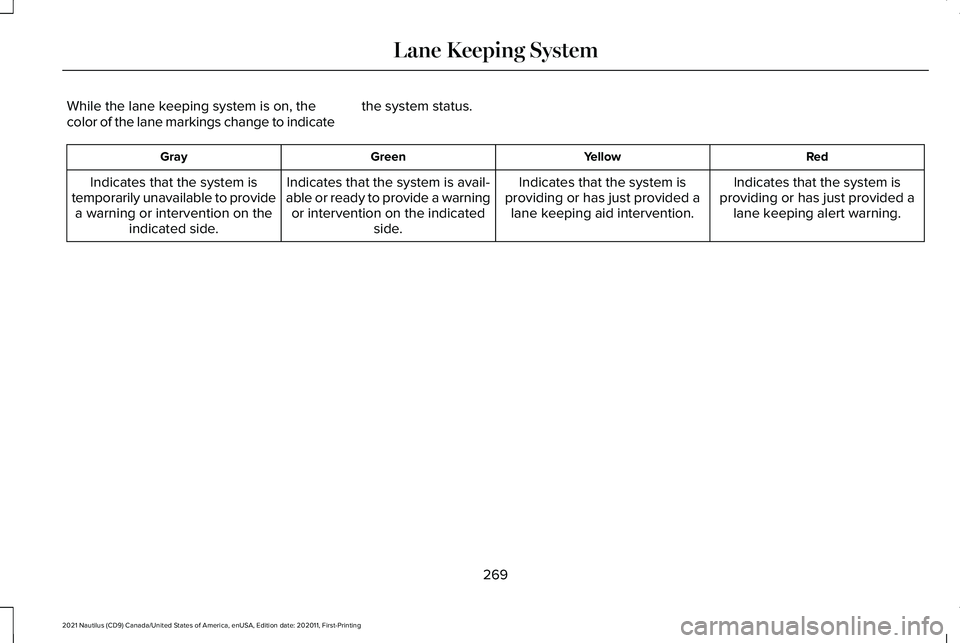
While the lane keeping system is on, the
color of the lane markings change to indicate
the system status. Red
Yellow
Green
Gray
Indicates that the system is
providing or has just provided a lane keeping alert warning.
Indicates that the system is
providing or has just provided a lane keeping aid intervention.
Indicates that the system is avail-
able or ready to provide a warning or intervention on the indicated side.
Indicates that the system is
temporarily unavailable to provide a warning or intervention on the indicated side.
269
2021 Nautilus (CD9) Canada/United States of America, enUSA, Edition date: 202011, First-Printing Lane Keeping System
Page 274 of 579
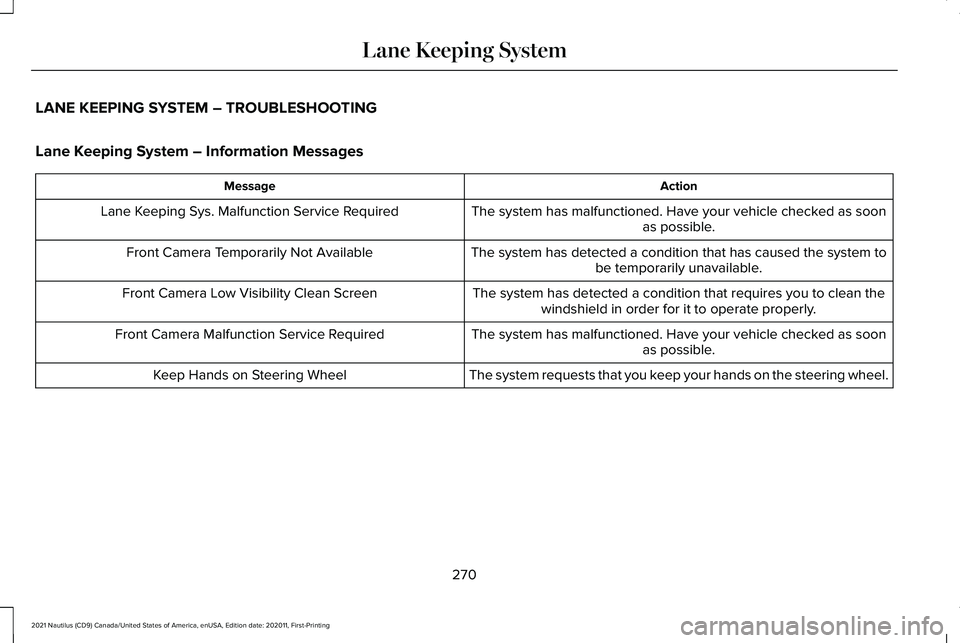
LANE KEEPING SYSTEM – TROUBLESHOOTING
Lane Keeping System – Information Messages
Action
Message
The system has malfunctioned. Have your vehicle checked as soonas possible.
Lane Keeping Sys. Malfunction Service Required
The system has detected a condition that has caused the system tobe temporarily unavailable.
Front Camera Temporarily Not Available
The system has detected a condition that requires you to clean thewindshield in order for it to operate properly.
Front Camera Low Visibility Clean Screen
The system has malfunctioned. Have your vehicle checked as soonas possible.
Front Camera Malfunction Service Required
The system requests that you keep your hands on the steering wheel.
Keep Hands on Steering Wheel
270
2021 Nautilus (CD9) Canada/United States of America, enUSA, Edition date: 202011, First-Printing Lane Keeping System
Page 275 of 579
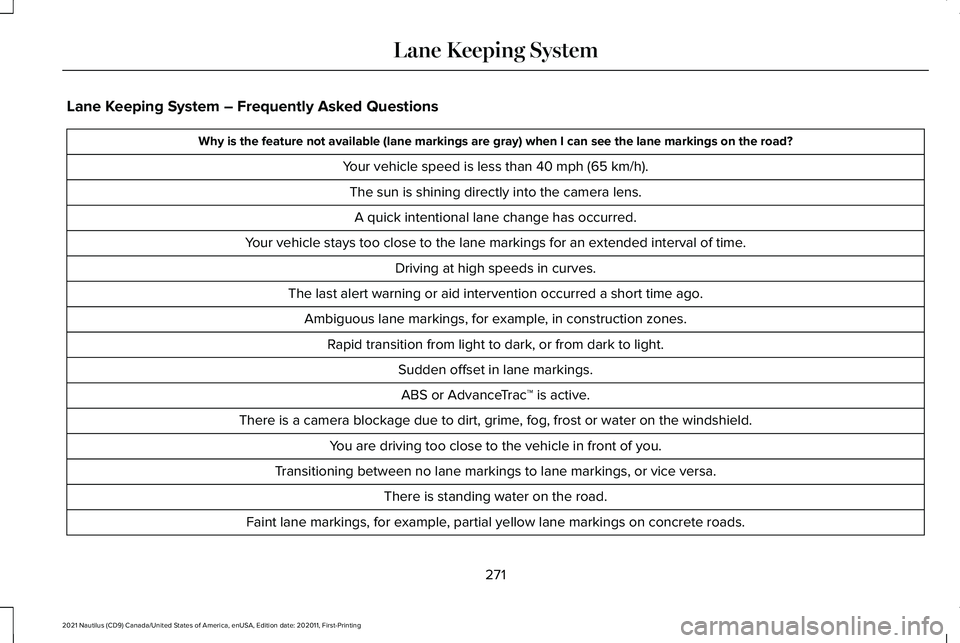
Lane Keeping System – Frequently Asked Questions
Why is the feature not available (lane markings are gray) when I can s\
ee the lane markings on the road?
Your vehicle speed is less than 40 mph (65 km/h).
The sun is shining directly into the camera lens. A quick intentional lane change has occurred.
Your vehicle stays too close to the lane markings for an extended interva\
l of time. Driving at high speeds in curves.
The last alert warning or aid intervention occurred a short time ago. Ambiguous lane markings, for example, in construction zones. Rapid transition from light to dark, or from dark to light. Sudden offset in lane markings.ABS or AdvanceTrac ™ is active.
There is a camera blockage due to dirt, grime, fog, frost or water on the windshield. You are driving too close to the vehicle in front of you.
Transitioning between no lane markings to lane markings, or vice versa. There is standing water on the road.
Faint lane markings, for example, partial yellow lane markings on concrete roads.
271
2021 Nautilus (CD9) Canada/United States of America, enUSA, Edition date: 202011, First-Printing Lane Keeping System
Page 276 of 579
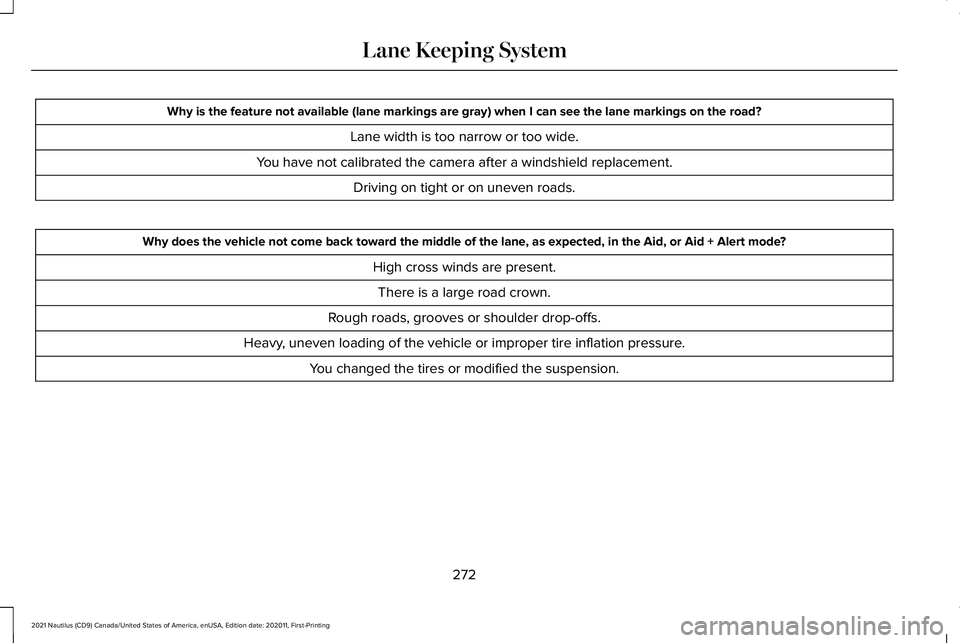
Why is the feature not available (lane markings are gray) when I can s\
ee the lane markings on the road?
Lane width is too narrow or too wide.
You have not calibrated the camera after a windshield replacement. Driving on tight or on uneven roads. Why does the vehicle not come back toward the middle of the lane, as expected, in the Aid, or Aid + Alert mode?
High cross winds are present.There is a large road crown.
Rough roads, grooves or shoulder drop-offs.
Heavy, uneven loading of the vehicle or improper tire inflation pressure. You changed the tires or modified the suspension.
272
2021 Nautilus (CD9) Canada/United States of America, enUSA, Edition date: 202011, First-Printing Lane Keeping System
Page 277 of 579
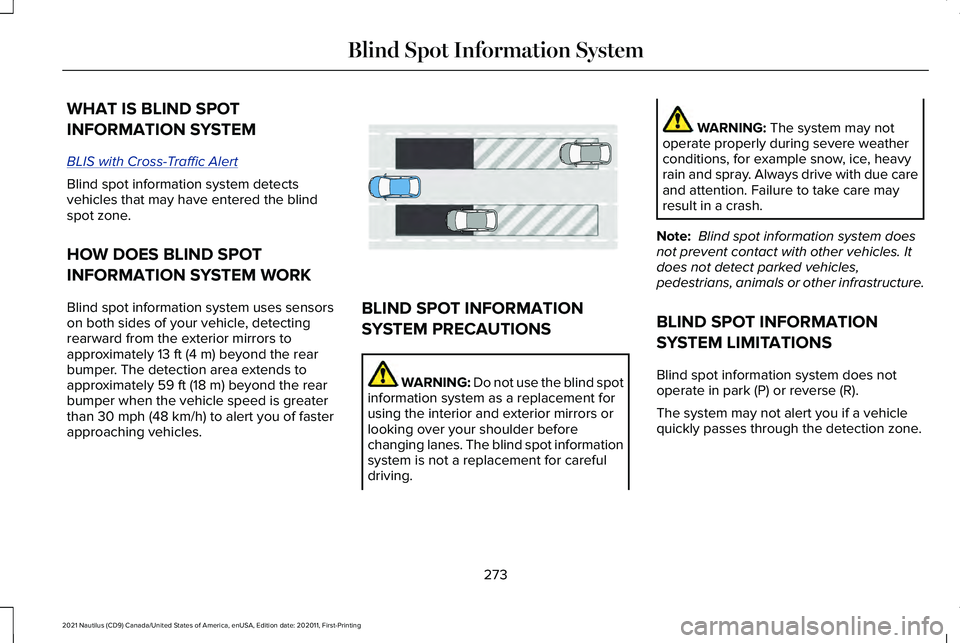
WHAT IS BLIND SPOT
INFORMATION SYSTEM
BLIS with Cross-T
raffic Alert
Blind spot information system detects
vehicles that may have entered the blind
spot zone.
HOW DOES BLIND SPOT
INFORMATION SYSTEM WORK
Blind spot information system uses sensors
on both sides of your vehicle, detecting
rearward from the exterior mirrors to
approximately 13 ft (4 m) beyond the rear
bumper. The detection area extends to
approximately
59 ft (18 m) beyond the rear
bumper when the vehicle speed is greater
than
30 mph (48 km/h) to alert you of faster
approaching vehicles. BLIND SPOT INFORMATION
SYSTEM PRECAUTIONS
WARNING:
Do not use the blind spot
information system as a replacement for
using the interior and exterior mirrors or
looking over your shoulder before
changing lanes. The blind spot information
system is not a replacement for careful
driving. WARNING:
The system may not
operate properly during severe weather
conditions, for example snow, ice, heavy
rain and spray. Always drive with due care
and attention. Failure to take care may
result in a crash.
Note: Blind spot information system does
not prevent contact with other vehicles. It
does not detect parked vehicles,
pedestrians, animals or other infrastructure.
BLIND SPOT INFORMATION
SYSTEM LIMITATIONS
Blind spot information system does not
operate in park (P) or reverse (R).
The system may not alert you if a vehicle
quickly passes through the detection zone.
273
2021 Nautilus (CD9) Canada/United States of America, enUSA, Edition date: 202011, First-Printing Blind Spot Information SystemE255695
Page 278 of 579
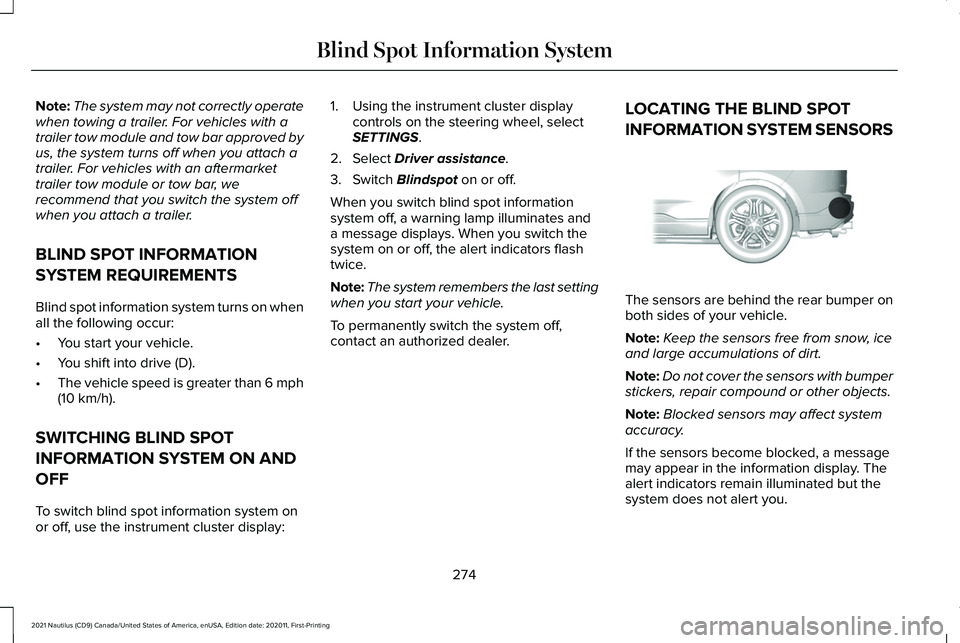
Note:
The system may not correctly operate
when towing a trailer. For vehicles with a
trailer tow module and tow bar approved by
us, the system turns off when you attach a
trailer. For vehicles with an aftermarket
trailer tow module or tow bar, we
recommend that you switch the system off
when you attach a trailer.
BLIND SPOT INFORMATION
SYSTEM REQUIREMENTS
Blind spot information system turns on when
all the following occur:
• You start your vehicle.
• You shift into drive (D).
• The vehicle speed is greater than 6 mph
(10 km/h).
SWITCHING BLIND SPOT
INFORMATION SYSTEM ON AND
OFF
To switch blind spot information system on
or off, use the instrument cluster display: 1. Using the instrument cluster display
controls on the steering wheel, select
SETTINGS
.
2. Select
Driver assistance.
3. Switch
Blindspot on or off.
When you switch blind spot information
system off, a warning lamp illuminates and
a message displays. When you switch the
system on or off, the alert indicators flash
twice.
Note: The system remembers the last setting
when you start your vehicle.
To permanently switch the system off,
contact an authorized dealer. LOCATING THE BLIND SPOT
INFORMATION SYSTEM SENSORS The sensors are behind the rear bumper on
both sides of your vehicle.
Note:
Keep the sensors free from snow, ice
and large accumulations of dirt.
Note: Do not cover the sensors with bumper
stickers, repair compound or other objects.
Note: Blocked sensors may affect system
accuracy.
If the sensors become blocked, a message
may appear in the information display. The
alert indicators remain illuminated but the
system does not alert you.
274
2021 Nautilus (CD9) Canada/United States of America, enUSA, Edition date: 202011, First-Printing Blind Spot Information SystemE205199
Page 279 of 579
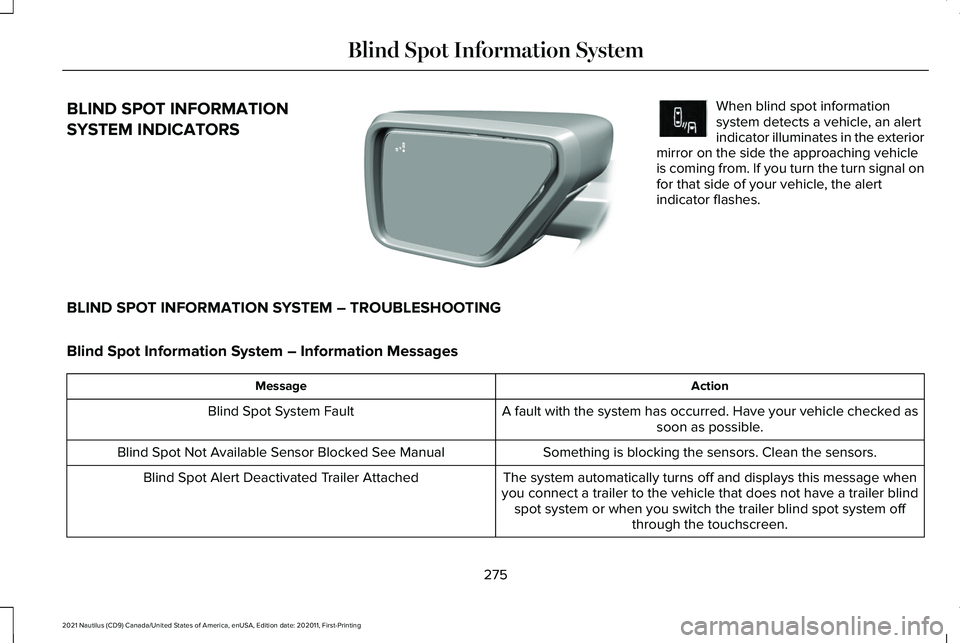
BLIND SPOT INFORMATION
SYSTEM INDICATORS When blind spot information
system detects a vehicle, an alert
indicator illuminates in the exterior
mirror on the side the approaching vehicle
is coming from. If you turn the turn signal on
for that side of your vehicle, the alert
indicator flashes.
BLIND SPOT INFORMATION SYSTEM – TROUBLESHOOTING
Blind Spot Information System – Information Messages Action
Message
A fault with the system has occurred. Have your vehicle checked assoon as possible.
Blind Spot System Fault
Something is blocking the sensors. Clean the sensors.
Blind Spot Not Available Sensor Blocked See Manual
The system automatically turns off and displays this message when
you connect a trailer to the vehicle that does not have a trailer blind spot system or when you switch the trailer blind spot system off through the touchscreen.
Blind Spot Alert Deactivated Trailer Attached
275
2021 Nautilus (CD9) Canada/United States of America, enUSA, Edition date: 202011, First-Printing Blind Spot Information SystemE309137 E249861E249861
Page 280 of 579
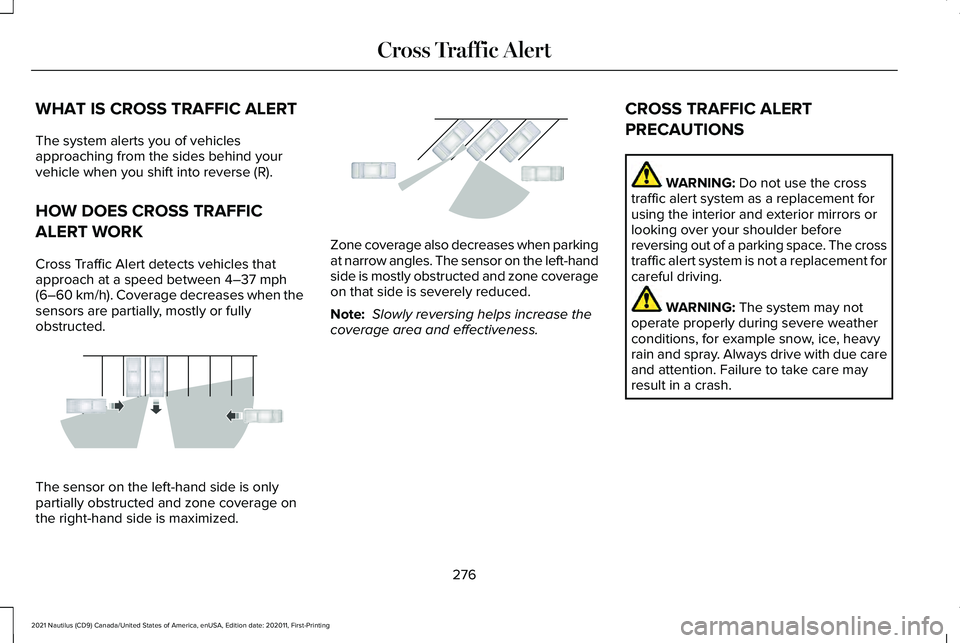
WHAT IS CROSS TRAFFIC ALERT
The system alerts you of vehicles
approaching from the sides behind your
vehicle when you shift into reverse (R).
HOW DOES CROSS TRAFFIC
ALERT WORK
Cross Traffic Alert detects vehicles that
approach at a speed between 4–37 mph
(6–60 km/h). Coverage decreases when the
sensors are partially, mostly or fully
obstructed. The sensor on the left-hand side is only
partially obstructed and zone coverage on
the right-hand side is maximized. Zone coverage also decreases when parking
at narrow angles. The sensor on the left-hand
side is mostly obstructed and zone coverage
on that side is severely reduced.
Note:
Slowly reversing helps increase the
coverage area and effectiveness. CROSS TRAFFIC ALERT
PRECAUTIONS WARNING:
Do not use the cross
traffic alert system as a replacement for
using the interior and exterior mirrors or
looking over your shoulder before
reversing out of a parking space. The cross
traffic alert system is not a replacement for
careful driving. WARNING:
The system may not
operate properly during severe weather
conditions, for example snow, ice, heavy
rain and spray. Always drive with due care
and attention. Failure to take care may
result in a crash.
276
2021 Nautilus (CD9) Canada/United States of America, enUSA, Edition date: 202011, First-Printing Cross Traffic AlertE142440 E142441